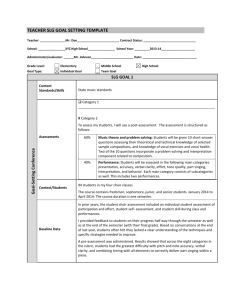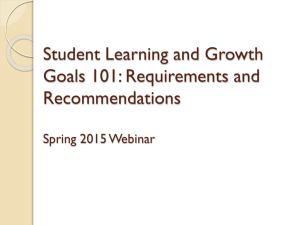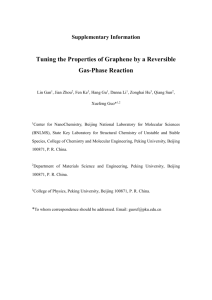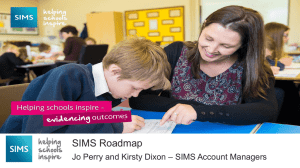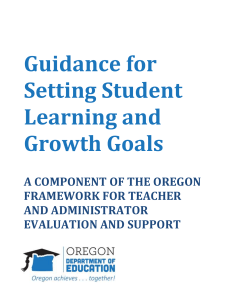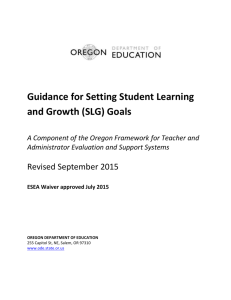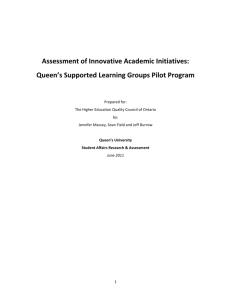Facilitator Guide - Oregon Department of Education
advertisement
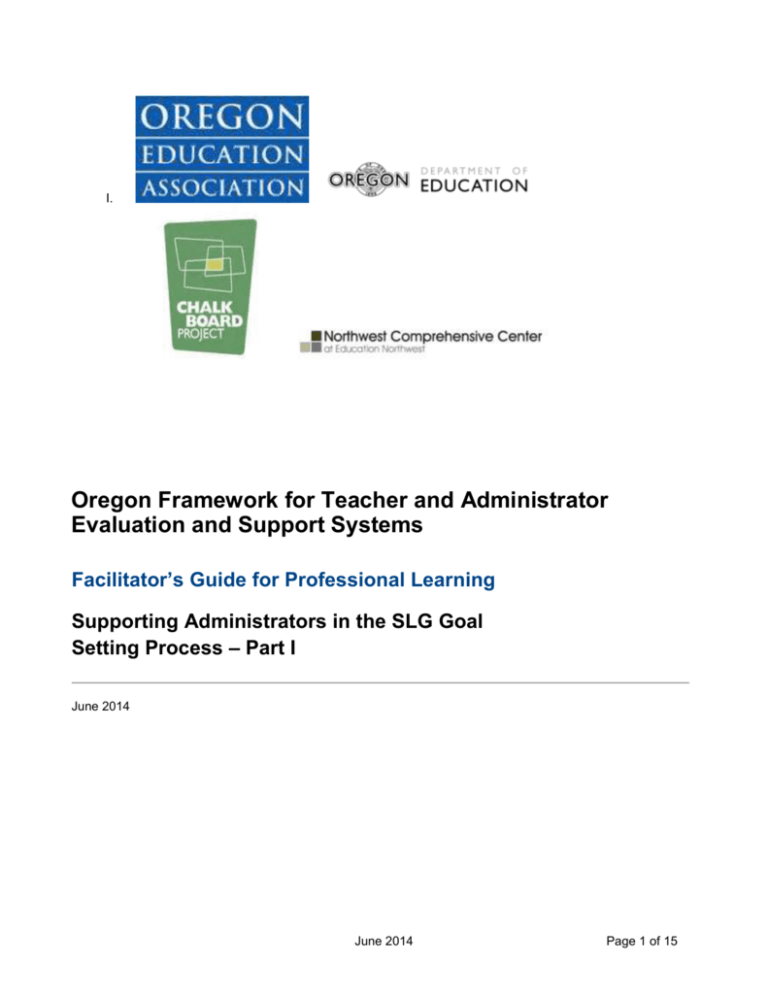
I. Oregon Framework for Teacher and Administrator Evaluation and Support Systems Facilitator’s Guide for Professional Learning Supporting Administrators in the SLG Goal Setting Process – Part I June 2014 June 2014 Page 1 of 15 Supporting Administrators in the SLG Goal Setting Process – Part I Module Overview Supporting Administrators in the Student Learning and Growth Goal Setting Process Part I is the first of two modules that focus on a deeper examination of the required components of SLG goals and engages participants in the examination of goals by component. Context Part I focuses on the writing of strong student learning and growth goals. collection of evidence in preparation for formative or summative evaluations. This module provides a discussion of the purpose of each SLG Goal component and engages participants in an examination of exemplar goals. This learning is then applied as participants review their own goals and think critically about how they might be changed. Administrators will need the information presented in this session to prepare them to complete their SLG Goals in the fall. Intended Outcomes At the end of this session, participants will be able to: Understand the connection/relationship between content and assessment Understand the connection/relationship between context and baseline data Revise a previously written goal based on what is learned June 2014 Page 2 of 15 Agenda I. Welcome and Outcomes (10 minutes) II. Understanding SLG Goals Process (45 minutes) III. IV. V. Successes & Roadblocks (10 minutes) Clarifications & Revisions (15 minutes) Connecting Content and Assessment (1 hour) Defining Content (5 minutes) Content Activity: High School Chemistry (10 minutes) Reflecting on Content (15 minutes) Defining Assessment (5 minutes) Assessment Activity: High School Chemistry (10 minutes) Reflecting on Assessment (15 minutes) Connecting Context and Baseline Data (1 hour) Defining Context (5 minutes) Context Activity: Elementary Reading (10 minutes) Reflecting on Context (15 minutes) Defining Baseline Data (5 minutes) Baseline Data Activity: Elementary Reading (10 minutes) Reflecting on Baseline Data (15 minutes) Applying What We’ve Learned: Sample SLG Activity Wrap-Up (10 minutes) June 2014 Page 3 of 15 Equipment and Materials Equipment: Laptop computer with copy of Module PowerPoint, projector Materials: Make a copy of the Participant Handout packet for each participant. Packet includes: o o o o Sample Template SLG Scoring Rubric Quality Goal Review Checklist Example components Put the following materials on each table: o Highlighters—for Content Activity o Markers o Post-it Notes o Index Cards – for end of day reflection Bring the following materials for use by you: o Markers o Chart paper for Parking Lot questions June 2014 Page 4 of 15 Facilitator Guide I. Welcome and Outcomes (5 minutes) Slide 1 is the title slide. Slide 2 Slide 2 During this slide, welcome participants, introduce yourself, and ask participants to briefly do the same with their first name and role at their table. This slide includes the outcomes for the professional learning focused on setting student learning and growth goals during the 2014-15 school year. Slide 3 Explain: “Last year was the first year that many of you set student learning and growth goals. This module is the first in a series that will continue throughout the 2014-15 school year to help deepen your understanding of the components of growth goals and support you in refining your skill in developing these goals.” June 2014 Page 5 of 15 II. Understanding SLG Goals (45 minutes) Slide 3 Explain: Slide 3 “By the end of the session, you will have a deeper understanding of four of the eight components of student learning and growth goals. “You will understand the connections between the individual components of content and assessment and of context and baseline data, and how they work together. “You will also examine the goal you brought with you today in light of what you learn to determine how it might be changed.” Handout 1 in your participant packet you will find the definitions for each of the 8 components. They are provided for your reference as we work through each section. Handout 2 shows a blank SLG Goal setting template with all the categories listed.” Slide 4 Explain: “Before we dive into the components, we’ll spend a few minutes talking about how we got here. Slide 4 The student learning and growth goal setting process began with SB290 and the ESEA waiver, and continues to evolve based on feedback received from the federal government and what has been learned through the pilot district process. Oregon has made it a priority that this work be based on the needs of educators. It is important to note that in Oregon’s process goal setting originates with the educator. The goal setting process is collaborative, but the educator uses data about him/herself and his/her students to determine the goal. Goals are not provided to educators by their evaluator. Additionally, Oregon has worked hard to refine the definition of teacher so that the process is meaningful for those who engage in it. So does that mean that the only purpose of setting SLG goals is to meet a state and federal requirement? Not at all. SLG goals offers us an opportunity to examine our practice, engage in collaborative conversations about that practice, receive recognition for our strengths, and support where we need it. In addition, it helps us think intentionally about what our students need and how we are going to support them in getting there.” June 2014 Page 6 of 15 Connecting Activity: Successes and Roadblocks (10 minutes) Purpose and intended outcomes: The purpose of this activity is for participants to have the opportunity to share their experiences implementing the student learning and growth goal process over the last year. Participants are asked to engage in conversation with someone not at their table. Facilitator should emphasize that discussion of successes come first. At the end of the activity, volunteers will share out experiences to the whole group. Activity detail: Slide 5 – Explain “For most of us, the student learning and growth goal setting process has been a new experience. Please take a few minutes to talk with someone not at your table about personal successes/learnings this year that were the result of the student learning and growth goal setting process. We’ll ask you to start with successes, and then move to challenges.”(5 min) Explain: “Now spend a few minutes talking about roadblocks or challenges you faced.” (5 min) Ask for volunteers to share out. Presenter should take notes on the roadblocks for possible reference in the clarifications section. Clarifications & Revisions (10 minutes) Slide 6 Explain: Explain: Though districts engaged in the SLG goal setting process over the last year, there are sometimes misconceptions that need to be clarified. The questions you see on this slide highlight some of the most common. Please note that two questions have asterisks next to them. Because USED has not yet provided official approval of Oregon’s waiver plan, these answers are subject to change.” If any of the questions listed surfaced as challenges or roadblocks during the previous activity, be sure to address them. Where does goal setting originate: Goal setting begins with the individual educator, and is then a part of a collaborative process within their school and/or district and with the educator’s evaluator. What is the role of SLG goals in overall evaluation? NOTE: It is important in this answer to emphasize that the focus of a district’s evaluation and support system should be on supporting educators in improving their practice. SLGGs play a small part in an educator’s overall evaluation. For the final summative score, ODE has proposed for the purposes of the waiver that it count for at least 20% of the total score. Districts may choose to have it be a larger percentage. This is pending USED approval and may change. June 2014 Page 7 of 15 Who has to set SLGs? Specific educators who are identified in SLG Guidance and FAQs provided by the state. Who are SLG goals set for? Not necessarily all students you teach/lead, depends on your role/level. Students in a course or class, or a specific instructional timeframe for interventionists; students who are present for both the pre and post assessment (intact group) What kinds of assessments can be used? As part of the waiver, ODE is proposing 2 categories of assessments. These have not yet received final approval from USED: Category 1 assessments are required state assessments. In Oregon, this includes SMARTER Balanced (formerly OAKS) and Extended Assessments in ELA and Math, at grades 3-8 and 11. Category 2 assessments are school-wide or district-wide assessments that have been purchased or developed by the school or district. They can include, but are not limited to: Commercially developed assessments that include pre- and post-measures Locally developed assessments that include pre- and post-measures Results from proficiency-based assessment systems Locally-developed collections of evidence, i.e. portfolios of student work that include multiple types of performance Classroom measures developed by individual teachers would not meet this requirement. What is the scope of SLG goals? SLG goals are intended to be focused and not reflective of all, or even a large percentage, of what is covered by an educator in their specific content. It should represent an intersection of two central points: Student need as identified through analysis of baseline data, and areas for improvement identified by the educator through self-reflection and data analysis. The learning targets identified in the goal should be reflective of a standard or limited, interrelated set of standards within a content area. The content area of “American History” is far too broad and is not the intent of the SLG process. What is the difference between academic achievement and academic growth? Achievement refers to the attainment of proficiency in relation to specific standard, set of standards, or a specific content area. Growth refers to student’s progress toward achievement from an individual baseline starting point. Slide 7 Explain: “Many of you are probably familiar with the guidance for SLG goal setting put out last September. That guidance has recently been revised, based on feedback from USED as well as lessons learned from pilot districts. I’d like to share three changes that will impact goal setting for next year.” “First, a Rationale section was added to the goal setting template. The purpose of the Rationale is to provide a detailed description of the reasons for selecting a specific area or focus for a goal. The June 2014 Page 8 of 15 Rationale should include a discussion of baseline data as well as current practice within the school and/or classroom as a way to provide evidence for the goal selection. You are trying to answer the question ‘Why do I think this is the most important knowledge/skills my students should attain as the result of instruction?’” “Second, as you heard earlier this morning, there are now only two categories of assessments for SLG goals: Category 1, which encompass Oregon’s state assessments, and Category 2 which include commercially and locally developed assessments that contain pre and post measures, as well as results from proficiency-based assessment systems and locally-developed collections of evidence such as portfolios of student work that include multiple types of performance.” “Finally, two tools have been developed for evaluating SLG goals. The Quality Goal Review Checklist includes a list of criteria that must be must be met before an SLG goal can be approved. The SLG Scoring Rubric is used for scoring individual SLG goals to determine whether each student exceeded, met, or did not meet the target; and the percentage of students in each category. Copies of both these tools can be found in your packet.” Slide 8 Explain: “ODE has received additional guidance from USED on goal setting for administrators. Previous guidance put out by ODE indicated that administrator goals had to address all the grades within the school. The new guidance is that administrator SLG goals can focus more narrowly on one or two grade levels, if the data warrants it. For example, if the analysis of school data shows that primary mathematics is the highest area of need the administrator could set a goal for K-2 students in math. The previous version of the guidance also indicated that administrators could set one of their goals in a non-academic area such as behavior, graduation rates, attendance, etc. In the revised guidance the USED has made clear that all administrators SLG goals must be focused on academic growth. Administrators are free to set professional goals in non-academic areas or use non-academic areas as strategies to meet academic goals.” Slide 9 - Before you begin looking at the components, talk with participants about group norms or agreements. These are proposed agreements—modify them to meet the needs of your group. ◦ Fully present ◦ Share your expertise ◦ Equity of voice ◦ Active listening ◦ Respect the current speaker – no side conversations ◦ Safety to share different opinions and perspectives ◦ Respectful use of technology June 2014 Page 9 of 15 III. Connecting Content and Assessment (1 hour) Slide 10 Content (30 min) Purpose and intended outcomes: The purpose of these activities is for participants to delve into the content and assessment components of the process and understand their connection. Facilitation notes: Participants are asked to examine an example using HS Writing. They will highlight the content examples to identify the knowledge, skills and standards addressed in the example. Activity detail: Explain: “Look at the template in your packet. You’ll see that there are eight components in a quality SLG Goal. Today’s session will focus on the first four. We’ll start with Content. Read the definition on the slide and discuss the purpose of content. What is the focused, deep, content that you are going to measure student progress on? It should be specific, but broad enough to cover the period of instruction and be based on an analysis of student data and areas where the educator sees potential for improvement in their practice. It is not a list of standards, and it is not all the content to be taught in the course. For example, the CCSS for Mathematics would not qualify.” Slide 11 - ACTIVITY: Uses Handout 3 “Read the example provided for content in your packet. Using the highlighters at your table, highlight on your copy with three different colors the following information: Knowledge students will gain should be highlighted in YELLOW The skills students should be able to demonstrate should be highlighted in BLUE (hint: verbs are likely to be your clue) Specific standards addressed by the content should be highlighted in PINK” ANSWERS ARE ON SLIDE 12 Facilitator should ask for volunteers to share out for each category. Show the highlighted slide as the “answer”. Slide 13 - Reflection: Explain: “Take some time now to think individually about the content component of the goal you brought in light of what you’ve just heard and using the guiding questions on the screen.” Give participants 3 minutes of individual think time. Then ask them to discuss with a partner at their table. “Turn to someone at your table and discuss how you might adapt/modify the content of your goal based on what you’ve learned.” June 2014 Page 10 of 15 Slide 14 Assessment (30 min) Facilitation notes: Participants are asked to examine an example using HS Writing. They will answer several questions using the assessment component example. Activity detail: Read the definition on the slide and then discuss the purpose of assessment. Explain: “Assessment is a broad concept. Assessment does not mean just sitting down and taking a test, though tests are one form of assessment. Results from proficiency-based assessment systems, locally developed collections of evidence, i.e. portfolios of student work that include multiple types of performance are all examples of assessments.” Slide 15 - ACTIVITY: Uses Handout 4 “Read the example provided for assessment in your packet. Take a minute to answer the questions on your own. When I give you the signal, make eye contact with someone not at your table and share your answers. Then we’ll get back together as a group and share out.” How is learning measured? Which categories do the assessments fall under? Are the assessments aligned with standards and do they meet state criteria? Facilitator should ask for volunteers to share out for each category. Show the next slide as the “answer”. Slide 16 - ANSWERS: How is learning measured? Performance tasks Which categories do the assessments fall under? Category 2 Are the assessments aligned with standards and do they meet state criteria? YES – use state scoring guide Slide 17 - Reflection: Explain: “Take some time now to think individually about the assessment component of the goal you brought in light of what you’ve just discussed and using the guiding questions on the screen. Give participants 3 minutes of individual think time. “Turn to someone at your table and discuss how you could adapt/modify the assessment component of your goal based on what you’ve learned.” June 2014 Page 11 of 15 IV. Connecting Content and Assessment (1 hour) Context (30 min) Purpose and intended outcomes: The purpose of the next two activities is for participants to delve into the context and baseline data components of the process and understand their connection. Facilitation notes: Participants are asked to examine an example using MS math. They will identify the data points included in a context example. Activity detail: Read the definition on the slide and then discuss the purpose of context. Slide 18 - Explain: “Context is all about identifying the characteristics of your students and circumstances of instruction (such as time) that might impact learning. It requires a conversation about the make-up of the community you serve. Context is important because it will help you set appropriate goals and identify strategies that will best serve the needs of your students in the time period allocated.” Slide 19 - ACTIVITY: Uses Handout 5 Explain: “Context is all about identifying the characteristics of your students and circumstances of instruction (such as time) that might impact learning. It requires a conversation about the make-up of the community you serve. Context is important because it will help you set appropriate goals and identify strategies that will best serve the needs of your students in the time period allocated. It is important to remember that context is not used in isolation to set goals, it is used in conjunction with the baseline data that has been gathered which we will talk about in the next section. Context is not what determines goals or the setting of tiers, rather it is additional data that informs these two things. This list is not finite. You probably have some additional examples of context that you can think of. Find someone in the room that you have not talked to yet and share any other context data points you have found to be valuable.” “Take a few minutes to independently identify the examples of context provided in this goal”. Call on volunteers for answers: (number, gender, learning needs, socio/econ, time period) Ask: “What additional information would you want to have in order to be able to set appropriate goals for these students?” Examples: What are their IEPs for? Are there any twice exceptional TAG students? Slide 20 - Reflection: Explain: “Take some time now to think individually about the context component of the goal you brought in light of what you’ve just discussed using the guiding questions on the screen.” June 2014 Page 12 of 15 Give participants 3 minutes of individual think time. “Turn to someone at your table and discuss how you could adapt/modify the context component of your goal based on what you’ve learned.” Baseline Data (30 min) Purpose and intended outcomes: The purpose of this activity is for participants to delve into the context and baseline data components of the process and understand their connection. Facilitation notes: Participants are asked to examine an example using MS math. They will bring together context and baseline data to see if they have enough information to set goals. Activity detail: Read the definition on the slide and then discuss the purpose of baseline data. Slide 21 - Explain: “Use multiple data points where possible. Teachers acting as intervention specialists would use baseline data from the student’s core content classroom as well as formal assessments that they have administered as part of the intervention process. More information never hurts, but one good data point is better than multiple data points that do not inform the goal, or that provide the wrong information. The example we are about to review only has one data point.” Slide 22 - ACTIVITY: Uses Handout 6 “Take the context information you were just reviewing and the baseline data. You now know the characteristics of the students and their starting points. By analyzing this data as a whole, you are better equipped to make more accurate decisions as to whether one tier or more is appropriate for this group of students.This is the stage at which you would place each student in a tier based on their expected level of growth. You would now think about individual students and decide whether some students should move to a different tier based on individual characteristics. Since you do not have that information for this exercise, think about what characteristics of individual students and what teaching and learning characteristics would make a difference in placing them in the right tier or justify creating a new tier?” Example: you might start by setting three tiers corresponding to each group in the baseline data. If realistic especially with regard to the size of your school, you could take into consideration the fact that Patricia, based on her performance last year, belongs in Group 1 and should therefore be in Tier 1, but she is limited enough in her English proficiency that, although it did not impede her last year, it will this year, and therefore she should be in Tier 2. Slide 23 - Reflection: Explain: “Take some time now to think individually about the relationship between context and baseline data. Look at the goal you brought in light of what you’ve just discussed using the guiding questions on the screen.” June 2014 Page 13 of 15 Give participants 3 minutes of individual think time. “Turn to someone at your table and discuss how you could adapt/modify the context and baseline components of your goal as well as how you might use them more effectively in the goal setting process.” Applying What We’ve Learned (15 min) Purpose and intended outcomes: The purpose of this activity is to allow participants to apply what they have learned about the first four pieces of the student learning and growth goal setting process to a more complete example. Facilitation notes: The two examples are not of equal quality. Mr. Vasquez goal is stronger than Mrs. O’Shea. Participants should read the goals to themselves first, then work with others at their table to discuss the strengths and weaknesses of each goal and what suggestions they would make to the goal writer. Activity detail: Slide 24 “Now that you have had the opportunity to look deeper at the first four components of goal setting, I am going to ask you to apply what you have learned. At your tables you will see two different examples of a teacher SLG goal. The samples include not only the four components we talked about today, but the tiered targets and rationale. Take a few minutes to read through the examples on your own, then have a conversation with others at you table. What are the strengths and weaknesses of each goal? How could each goal be improved? We’ll take about 15 minutes to complete this activity.” Slide 25 Use this slide to engage participants in a discussion of what they found (Mr. Vasquez goal should be found overall to be stronger than Mrs. O’Shea.) V. Wrap-Up (10 minutes) Uses Handout 7 Explain Slide 26 You’ve had the opportunity today to think more deeply about several of the components of the SLG goal process. Take a few minutes now to review your goal using the Quality Review Checklist. Does the goal you wrote meet the criteria? If yes, indicate what evidence from your goal supports that finding. If no, what changes would you need to make? Explain: “We have done a lot of strategic thinking about the first four components Slide 27 June 2014 Page 14 of 15 of the goal setting process. Here at the end of the meeting, we are going to take a few minutes to reflect on what we have accomplished, and identify a few next steps that you need to complete individually. Use an index card from your table to write down: Two new learnings or “a-has” you had as a result of today’s professional learning One question you still have regarding the student learning and growth goal setting process.” Allow participants to have about 5 minutes to reflect on these questions. Suggested Homework Explain: “While the homework is certainly not mandatory, we think it’s a valuable opportunity for leadership teams to continue the discussion and work we started today. We recommend that you use what you’ve learned here today as you begin the goal writing process for the 2014-15 school year. We encourage you to bring a draft of one of your goals to the October PLT meeting where you will have the opportunity to do some similar deep examination of the other four components of the process.” June 2014 Slide 27 Page 15 of 15
